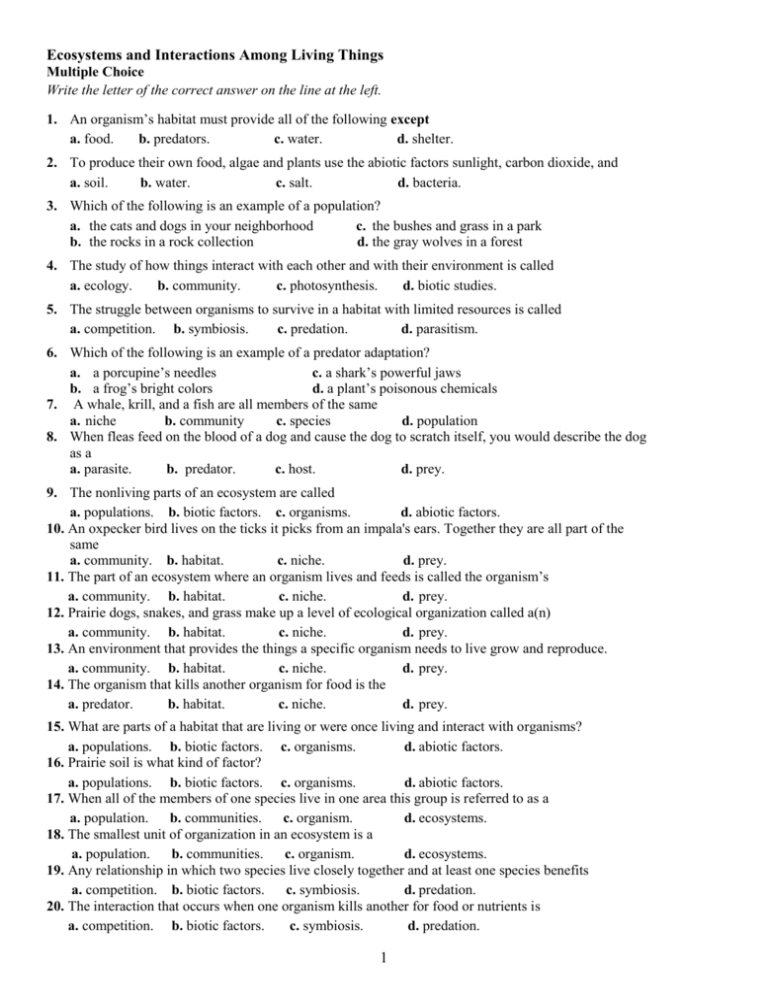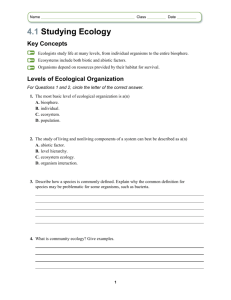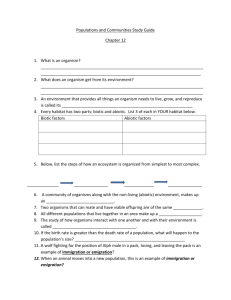Genetics: The Science of Heredity
advertisement

Ecosystems and Interactions Among Living Things Multiple Choice Write the letter of the correct answer on the line at the left. 1. An organism’s habitat must provide all of the following except a. food. b. predators. c. water. d. shelter. 2. To produce their own food, algae and plants use the abiotic factors sunlight, carbon dioxide, and a. soil. b. water. c. salt. d. bacteria. 3. Which of the following is an example of a population? a. the cats and dogs in your neighborhood c. the bushes and grass in a park b. the rocks in a rock collection d. the gray wolves in a forest 4. The study of how things interact with each other and with their environment is called a. ecology. b. community. c. photosynthesis. d. biotic studies. 5. The struggle between organisms to survive in a habitat with limited resources is called a. competition. b. symbiosis. c. predation. d. parasitism. 6. Which of the following is an example of a predator adaptation? a. a porcupine’s needles c. a shark’s powerful jaws b. a frog’s bright colors d. a plant’s poisonous chemicals 7. A whale, krill, and a fish are all members of the same a. niche b. community c. species d. population 8. When fleas feed on the blood of a dog and cause the dog to scratch itself, you would describe the dog as a a. parasite. b. predator. c. host. d. prey. 9. The nonliving parts of an ecosystem are called a. populations. b. biotic factors. c. organisms. d. abiotic factors. 10. An oxpecker bird lives on the ticks it picks from an impala's ears. Together they are all part of the same a. community. b. habitat. c. niche. d. prey. 11. The part of an ecosystem where an organism lives and feeds is called the organism’s a. community. b. habitat. c. niche. d. prey. 12. Prairie dogs, snakes, and grass make up a level of ecological organization called a(n) a. community. b. habitat. c. niche. d. prey. 13. An environment that provides the things a specific organism needs to live grow and reproduce. a. community. b. habitat. c. niche. d. prey. 14. The organism that kills another organism for food is the a. predator. b. habitat. c. niche. d. prey. 15. What are parts of a habitat that are living or were once living and interact with organisms? a. populations. b. biotic factors. c. organisms. d. abiotic factors. 16. Prairie soil is what kind of factor? a. populations. b. biotic factors. c. organisms. d. abiotic factors. 17. When all of the members of one species live in one area this group is referred to as a a. population. b. communities. c. organism. d. ecosystems. 18. The smallest unit of organization in an ecosystem is a a. population. b. communities. c. organism. d. ecosystems. 19. Any relationship in which two species live closely together and at least one species benefits a. competition. b. biotic factors. c. symbiosis. d. predation. 20. The interaction that occurs when one organism kills another for food or nutrients is a. competition. b. biotic factors. c. symbiosis. d. predation. 1 21. The organism that is harmed in a parasitic relationship is called a a. predator. b. host. c. parasite. d. food. 22. The organism that benefits from a parasitic relationship is called a a. predator. b. host. c. parasite. d. food. 23. Which of the following lists the levels of an ecosystem in order from largest to smallest a. population, organism, community, ecosystem b. ecosystem, community, organism, population c. organism, community, population, ecosystem d. ecosystem community, population, organism 24. Which of the following is a biotic factor? a. sunlight b. water c. bobcat d. temperature 25. All of the organisms that live in a particular area and their nonliving surroundings make up a(n) a. niche b. community c. ecosystem d. population 26. In a swamp ecosystem all the organisms that live there and that interact with each other would make up the a. organism b. community c. ecosystem d. population 27. If a predator population such as a wolf population increased. what would most likely happen to its prey population? a. nothing b. it would decrease c. it would increase d. the moose would attack the wolves Matching Match the different types of symbiosis with the correct definition or example. a. mutualism b. commensalism c. parasitism 28. A relationship that involves one organism living with, on, or inside another organism and harming it 29. Inside a human’s intestine live bacteria that make vitamin K 30. A relationship in which one species benefits and the other species is neither helped nor harmed. 31. A human picks up bacteria on his or her hands. The bacteria do not cause disease but do feed on the human’s dead skin cells. 32. A relationship in which both species benefit. 33. A tick attaches itself to a human and feeds on the human’s blood. 34. Stinging ants nest only in the acacia tree, whose thorns discourage the ants’ predators and provides the ants’ only food. The ants attack other animals that approach the tree and clear competing plants away from the base of the tree. 35. A person swallows a tape worm and it causes that person to lose weight and have many health problems. 36. A bird builds a nest in a tree. 37. The yucca tree is pollinated by the yucca moth as the yucca moth gets nectar 38. A vampire bat drinks the blood of horses 39. A remora fish attaches itself to the underside of a shark without harming the shark, and eats left over bits of food from the shark’s meals. 40. Dwarf mistletoe grows into the bark of trees to obtain water and nutrients.








